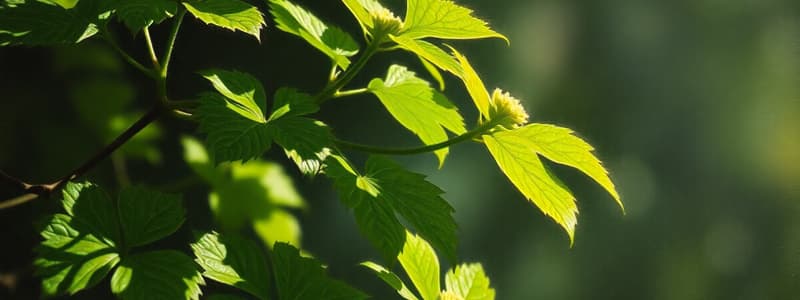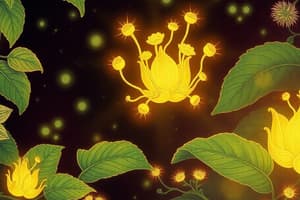Podcast
Questions and Answers
What is the main purpose of photosynthesis?
What is the main purpose of photosynthesis?
- To create carbohydrates using light energy (correct)
- To absorb carbon dioxide
- To release oxygen spontaneously
- To provide nutrients to soil
Chlorophyll absorbs green light and reflects blue and red light.
Chlorophyll absorbs green light and reflects blue and red light.
False (B)
What gas is produced as a byproduct of photosynthesis?
What gas is produced as a byproduct of photosynthesis?
Oxygen
The chemical equation for photosynthesis is 6H2O + 6CO2 + light energy → C6H12O6 + 6____.
The chemical equation for photosynthesis is 6H2O + 6CO2 + light energy → C6H12O6 + 6____.
Match the components of photosynthesis with their functions:
Match the components of photosynthesis with their functions:
Which of the following is NOT a product of the light-dependent reactions?
Which of the following is NOT a product of the light-dependent reactions?
The stroma is the space inside the thylakoids.
The stroma is the space inside the thylakoids.
What enzyme catalyzes the reaction of carbon fixation in the Calvin Cycle?
What enzyme catalyzes the reaction of carbon fixation in the Calvin Cycle?
Flashcards
Photosynthesis
Photosynthesis
Photosynthesis is the process by which plants use light energy to convert carbon dioxide and water into glucose (sugar) for energy, releasing oxygen as a byproduct.
Photosynthesis Equation
Photosynthesis Equation
The chemical equation for photosynthesis: 6H2O + 6CO2 + light energy → C6H12O6 + 6O2. Reactants: Water (H2O), Carbon dioxide (CO2) Products: Glucose (C6H12O6), Oxygen (O2)
Chloroplasts
Chloroplasts
Organelles in plant cells where photosynthesis takes place. They have two membranes, an inner and outer membrane enclosing the stroma. The stroma contains thylakoids; stacks of thylakoids form grana.
Chlorophyll
Chlorophyll
Signup and view all the flashcards
Light-dependent reactions
Light-dependent reactions
Signup and view all the flashcards
Light-independent reactions (Calvin Cycle)
Light-independent reactions (Calvin Cycle)
Signup and view all the flashcards
RuBP
RuBP
Signup and view all the flashcards
Rubisco
Rubisco
Signup and view all the flashcards
Study Notes
Photosynthesis Introduction
- Photosynthesis is the process of using light energy to create carbohydrates, which are also known as sugars.
Photosynthesis Equation
-
The chemical equation for photosynthesis is:
- 6H2O + 6CO2 + light energy → C6H12O6 + 6O2
-
Reactants:
- Water (H2O) enters the plant through the roots, and carbon dioxide (CO2) enters the plant through tiny openings called stomata on the leaves.
-
Products:
- Glucose (C6H12O6) is a simple sugar that is produced, and oxygen gas (O2) is released through the stomata.
Chloroplasts
-
Chloroplasts are organelles that carry out photosynthesis.
-
They have two membranes: an outer membrane and an inner membrane.
-
The space between the membranes is called the intermembrane space.
-
The inner membrane encloses a fluid called the stroma, which contains a network of interconnected sacs called thylakoids.
-
A stack of thylakoids is called a granum (plural: grana).
-
The fluid inside a thylakoid is called the lumen.
Chlorophyll
-
Chlorophyll is the pigment that absorbs light energy and is found in the thylakoids.
-
It absorbs blue and red light and reflects green light, which is why most plants appear green.
Photosynthesis Stages
- Photosynthesis consists of two main stages:
Light-Dependent Reactions
-
Occur within the thylakoids.
-
Steps:
- Light strikes photosystem II, exciting its electrons and causing them to flow to a mobile electron carrier called plastoquinone.
- Photosystem II replaces its lost electrons by oxidizing water, producing oxygen gas, hydrogen ions (H+), and electrons.
- Plastoquinone carries the electrons to the cytochrome b6f complex, pumping protons from the stroma into the lumen, creating a concentration gradient.
- Electrons continue to a copper-containing protein called plastocyanin, which transfers them to photosystem I.
- Photosystem I absorbs light energy, boosting the electrons, which then move to an iron-sulfur protein called ferredoxin.
- Ferredoxin transfers the electrons to NADP reductase, which reduces NADP+ to NADPH.
- The proton gradient drives hydrogen ions through ATP synthase, producing ATP.
-
Products:
- Oxygen (O2)
- ATP
- NADPH
Light-Independent Reactions (Calvin Cycle)
-
Occur in the stroma.
-
Steps:
- Carbon fixation: Carbon dioxide reacts with ribulose bisphosphate (RuBP), a five-carbon sugar, catalyzed by the enzyme rubisco, producing two molecules of 3-phosphoglycerate (PGA).
- Reduction: ATP and NADPH are used to convert PGA into glyceraldehyde-3-phosphate (G3P).
- Regeneration of RuBP: Most G3P is used to regenerate RuBP, while some is used to produce sugars like glucose.
Summary of Calvin Cycle Reactions
- Three molecules of CO2 produce one molecule of G3P.
- This requires nine ATP and six NADPH molecules.
- Six molecules of CO2 are needed to produce one molecule of glucose, requiring 18 ATP and 12 NADPH molecules.
Studying That Suits You
Use AI to generate personalized quizzes and flashcards to suit your learning preferences.



